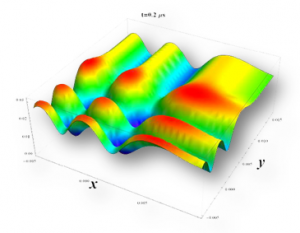Laboratory for quantum biophotonics
 The specific interactions of lasers and atoms that generate processes of coherent population capture are investigated, related phenomena of electromagnetically induced transparency and absorption, as well as nonlinear magneto-optical polarization rotations. Research is performed in hot vapors of alkali metal atoms. Our research also focuses on the area of slow and stopped lights as well as their application in all-optical signal switching. By measuring Zeman splitting of magnetic sublevels of alkali metals by quantum optics techniques it is possible to monitor the fluctuations of the magnetic field with the sensitivity of the femto Tesla. This sensitivity allows both the detection of brain waves and non-contact recording of heart muscle work. The magnetometers being developed in our laboratory are used in experiments to measure the electric dipole moment of neutrons (nEDM collaboration) and for the detection of exotic interactions with dark matter (axions, GNOME collaborations). In the near future, thanks to a project funded by the Federal Government of the Republic of Germany, a high-precision portable magnetometer will be developed for geomagnetic mapping of unexplored ore and archaeological sites.
The specific interactions of lasers and atoms that generate processes of coherent population capture are investigated, related phenomena of electromagnetically induced transparency and absorption, as well as nonlinear magneto-optical polarization rotations. Research is performed in hot vapors of alkali metal atoms. Our research also focuses on the area of slow and stopped lights as well as their application in all-optical signal switching. By measuring Zeman splitting of magnetic sublevels of alkali metals by quantum optics techniques it is possible to monitor the fluctuations of the magnetic field with the sensitivity of the femto Tesla. This sensitivity allows both the detection of brain waves and non-contact recording of heart muscle work. The magnetometers being developed in our laboratory are used in experiments to measure the electric dipole moment of neutrons (nEDM collaboration) and for the detection of exotic interactions with dark matter (axions, GNOME collaborations). In the near future, thanks to a project funded by the Federal Government of the Republic of Germany, a high-precision portable magnetometer will be developed for geomagnetic mapping of unexplored ore and archaeological sites.
In the field of biophotonics, optical properties of biological structures, primarily insects are investigated. Of interest are the parts of the body whose architecture has micron and submicron dimensions (photonic crystals, volume and surface lattices, nanoparticles) where interference and diffraction effects are observed. Spectral and polarization properties in a wide range of wavelengths (from ultraviolet to infrared and terahertz radiation), biological significance of such structures, as well as possibilities of their practical application in various fields of science and technology (sensors, selective filters, protective elements) are investigated. Different types of microscopy (electronic, optical, nonlinear), and spectroscopy and holography are used for analysis, and theoretical models of biophotonic structures are being developed.
Photosensitive materials based on polymers of biological origin (proteins and polysaccharides) are being developed: gelatin (collagen), silk (fibroin), pullulan, chitin, chitosan, dextran … The technology of direct laser drawing, which was developed in this laboratory, enable us to make complicated micro and nanostructures, such as: microlenses, microchannels, micromechanical components, surface and volume diffraction gratings. We are also working on potential applications in the field of sensors in combination with digital holography techniques, application of digital holography in biomechanical research, development of microfluidic structures for laboratory-on-a-chip (Lab-on-a-chip).
Infrared sensors based on photophoretic properties of biological structures, micromanipulation techniques and microprints for generating complex micro-optomechanical devices with the use of quantum mechanical detection
techniques are under development.
Head of the Laboratory fis Dr. Dušan Arsenović.
OUR RESEARCHERS
Dr. Dušan Arsenović
Dr. Darko Vasiljević
Dr. Željka Nikitović
Dr. Branko Kolarić
Dr. Zoran Grujić
Dr. Vladimir Damljanović
Dr. Branka Murić
Dr. Stanko Nikolić
Dr. Svetlana Savić Šević
Dr. Bojana Bokić
Dr. Jelena Dimitrijević
Dr. Marina Lekić
Dr. Danica Pavlović
Dušan Grujić
Vladimir Lazović
Ivan Radojčić
Marija Ćurčić
Filip Krajinić



